Choosing the wrong downlight for damp areas results in poor lighting and unhappy clients. This choice makes spaces look unnatural and affects mood. Understanding CRI and color temperature ensures you pick the perfect IP44 downlight.
Color Rendering Index (CRI) measures how accurately a light shows true colors, while color temperature describes the light's appearance from warm to cool. For IP44 downlights in wet or damp spaces like bathrooms, both are critical for creating the right atmosphere, ensuring safety, and achieving the desired look.
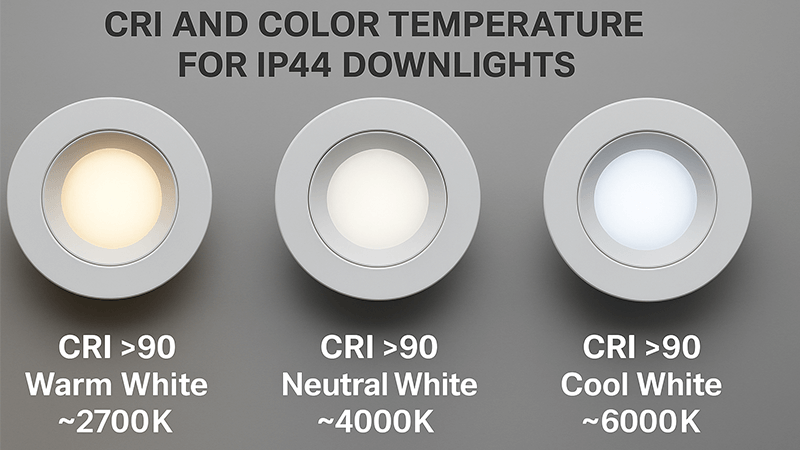
As someone who has spent his entire career in the lighting industry1, I've seen many projects succeed or fail based on two simple metrics: CRI and CCT. They sound technical, but the concepts are straightforward. Getting them right is the difference between a space that feels just okay and one that feels perfect. I want to break down these terms for you in a simple way, so you can select your next batch of IP44 downlight2s with complete confidence and deliver exceptional results for your clients. Let's dive in.
What is the difference between CRI and color temperature?
Are you confused by the terms CRI and CCT on spec sheets? It's a common issue that can lead to costly project mistakes and solutions that don’t meet client expectations.
Color Rendering Index (CRI)3 is about the quality of light and rates how well it reveals true colors. Correlated Color Temperature (CCT)4, on the other hand, is about the appearance of light and describes if it looks warm (yellowish) or cool (bluish).
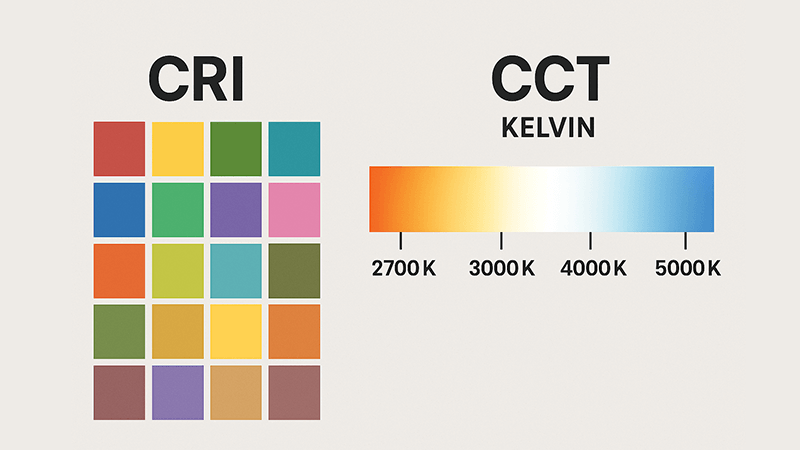
To really help my clients understand this, I often use an analogy. Think of CCT as the "color" of the light itself, like choosing a paint color for a wall—it sets the overall mood. CRI, however, is about how that light lets you see the true colors of everything else in the room, like your furniture, your clothes, and even your food. You can have a warm, cozy light (low CCT) that also shows colors beautifully (high CRI5). Let me break it down further.
Understanding Color Rendering Index (CRI)
CRI is measured on a scale from 0 to 100. A score of 100 means the light source shows colors just as they would appear under natural sunlight. A low CRI6 light, say below 80, can make objects look washed out or shift their colors. For example, a red apple might look dull and brownish. In my business, we consider a CRI of 80 the minimum standard for general lighting, but for areas where color is critical, I always push for 90 or higher. This ensures that skin tones look healthy, food looks appetizing, and retail products look vibrant. It’s all about color fidelity.
CCT is measured in Kelvin (K). The scale is a bit counterintuitive: the lower the Kelvin number, the "warmer" or more yellow the light appears. The higher the number, the "cooler" or bluer it gets.
- 2700K - 3000K: This is warm white. It feels cozy and relaxing, just like a traditional incandescent bulb. It's perfect for homes and restaurants.
- 4000K: This is neutral or cool white. It’s a clean and balanced light that is great for offices, retail stores, and modern kitchens.
- 5000K and above: This is daylight. It’s very crisp and blue-toned, promoting alertness. It's best used for task lighting, garages, and commercial applications.
Here is a simple table to show the key differences.
| Feature | Color Rendering Index (CRI) | Correlated Color Temperature (CCT) |
|---|---|---|
| What it Does | Measures the accuracy of color reproduction | Describes the color appearance of the light |
| Unit | A score from 0-100 (no units) | Measured in Kelvin (K) |
| Example | A CRI of 90+ shows vibrant, true-to-life colors | A CCT of 3000K produces a warm, yellowish light |
| Impact | Affects the quality and vividness of objects | Affects the mood and atmosphere of the space |
Getting both right is crucial. For a hotel bathroom project, we used IP44 downlights with a high CRI of 95 so guests could apply makeup accurately, but we chose a relaxing 3000K CCT to maintain a spa-like, luxurious feel. The client was thrilled with the result.
How important is CRI in lighting?
Have you ever looked in a mirror under bad lighting and thought you looked pale or sick? That's the effect of a low CRI. It can make everything look unnatural and unappealing.
CRI is extremely important because it directly impacts how we see our environment. High CRI lighting makes colors look vibrant and accurate, which is essential in almost any setting, from homes and hotels to retail stores, to ensure everything looks its best.
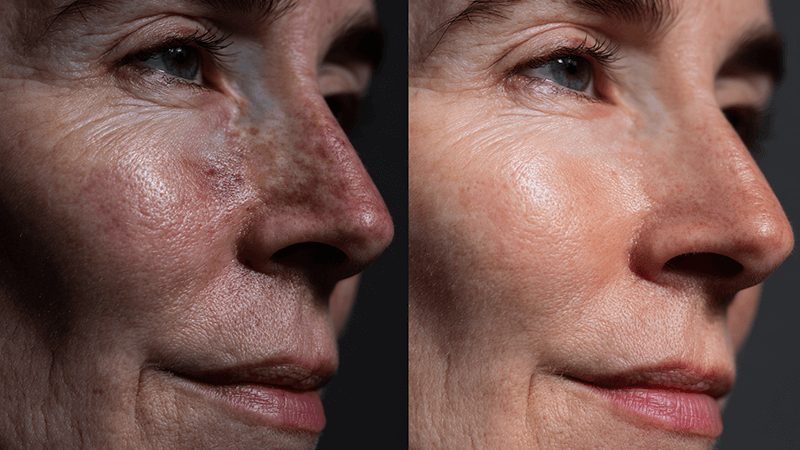
I can't overstate this: CRI is a mark of quality. A low CRI light source can save a few cents in manufacturing, but it completely undermines the user's experience. It’s a shortcut I’ve never been willing to take in my products. When you are specifying an IP44 downlight for a space where people will be, CRI really matters. Think about the specific applications you mentioned.
CRI in Commercial and Residential Spaces
In a residential bathroom, an IP44 downlight with high CRI is a must. When someone is getting ready in the morning, they need to see accurate skin tones. This is why for vanity and over-mirror lighting, I always recommend a CRI of 90 or higher. It ensures makeup colors are true and that there are no surprises when you step outside into natural daylight. We once had a contractor client who installed CRI 70 lights in a high-end apartment development's bathrooms to save costs. The complaints were immediate. We replaced them with our CRI 90+ downlights, and it completely transformed the space and satisfied the residents.
The same logic applies to commercial areas. For the shower entrances at a gym or poolside, lighting is part of the experience. High CRI makes the tile colors pop and creates a cleaner, more premium feel. It reflects the quality of the establishment. Low CRI lighting would make the same space feel cheap and dingy, no matter how clean it actually is.
What is a "Good" CRI Value?
Not all applications require a perfect CRI of 100. It's about matching the CRI level to the task. As a purchasing manager, knowing these tiers will help you make better sourcing decisions and avoid over-specifying or under-specifying for a project. Here’s a quick guide I share with my partners:
| CRI Value | Quality Level & Typical Applications |
|---|---|
| CRI 90+ (Excellent) | Essential for tasks needing color accuracy. Use in art galleries, retail dressing rooms, vanity lighting, medical facilities. |
| CRI 80-90 (Good) | The standard for quality general lighting. Ideal for most homes, offices, classrooms, and commercial spaces. |
| CRI <80 (Poor) | Acceptable only where color accuracy is not important. Use in parking garages, street lighting, some storage areas. |
At my company, we focus our production on CRI 80+ lights as a baseline. For any project where appearance is a key selling point, I guide my partners toward our CRI 90+ solutions. It’s an investment in quality that always pays off.
Why is color temperature important in lighting?
The light in a space can feel "off," but you can't quite explain why. The wrong color temperature can ruin the mood, making a relaxing area feel sterile or a work area feel sleepy.
Color temperature sets the mood of a room. Warm light, which has a low CCT, creates a cozy and inviting atmosphere. Cool light, with a high CCT, promotes alertness and focus. Choosing the right CCT is essential for the function you want a space to serve.
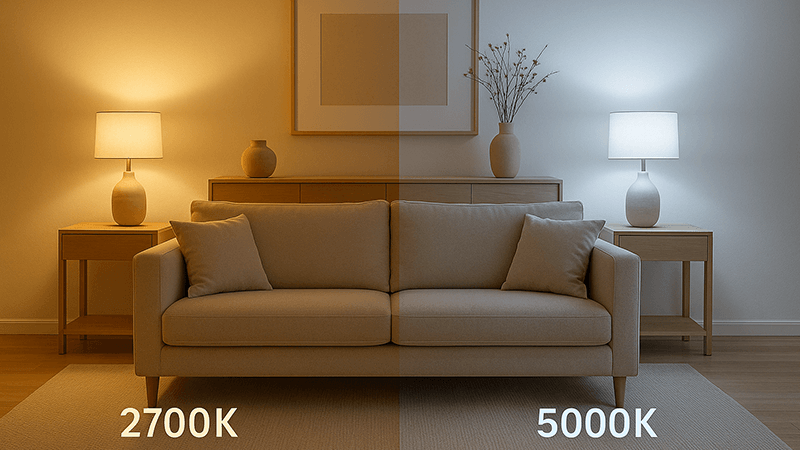
I think of CCT as the key to emotional design in lighting. It's how we make people feel in a space. A light's brightness (lumens) is important, but its color temperature is what creates the atmosphere. An IP44 downlight is a versatile product, but its CCT must be chosen carefully based on where it will be installed. Let's look at how this applies to specific damp-rated areas7.
Matching CCT to the Application's Mood
For an enclosed balcony that might get some occasional rain, the goal is often relaxation. Here, you'd want an IP44 downlight with a warm CCT, around 2700K to 3000K. This mimics the warm glow of sunset and makes the space feel like a comfortable extension of the living room. Installing a 5000K light here would feel harsh and clinical, ruining the calming vibe.
Conversely, for the entrance to a poolside shower, you might want a cleaner, more energizing feel. A neutral to cool white, like 4000K or 5000K, works beautifully. This CCT feels crisp, modern, and hygienic, which is perfect for that kind of functional, water-related space. I once consulted on a luxury spa project where they used 3000K in the relaxation lounges and massage rooms, but 4000K in the locker rooms and showers. This subtle shift in CCT guided the guests' moods from active and clean to relaxed and calm as they moved through the facility.
The Kelvin Scale Explained
Choosing the right CCT becomes easy once you associate the Kelvin numbers with their application and the feeling they create. As a buyer, this knowledge allows you to specify exactly what your project needs.
Here’s a table that breaks it down for typical IP44 downlight uses:
| Kelvin (K) | Type of Light | Common Applications for IP44 Downlights | Feeling Created |
|---|---|---|---|
| 2700K - 3000K | Warm White | Residential bathrooms, enclosed balconies, hotel rooms | Cozy, relaxing, intimate |
| 3500K - 4000K | Neutral White | Gym locker rooms, commercial restrooms, modern kitchens | Clean, balanced, welcoming |
| 5000K - 6500K | Cool White | Task-heavy areas, poolside showers, utility spaces | Alert, crisp, energizing |
By asking your client "How do you want this space to feel?", you can easily zero in on the right CCT and become a more valuable partner to them, not just a supplier.
Does color temperature affect lumens?
You've probably noticed that two LED lights with the same wattage can have different lumen output8s. This can make it hard to compare products and specify them accurately for a project.
Yes, color temperature can have a small effect on a light's lumen output. Generally, LED chips that produce a cooler CCT (like 5000K) are slightly more efficient and can produce more lumens per watt than those with a warmer CCT (like 3000K).
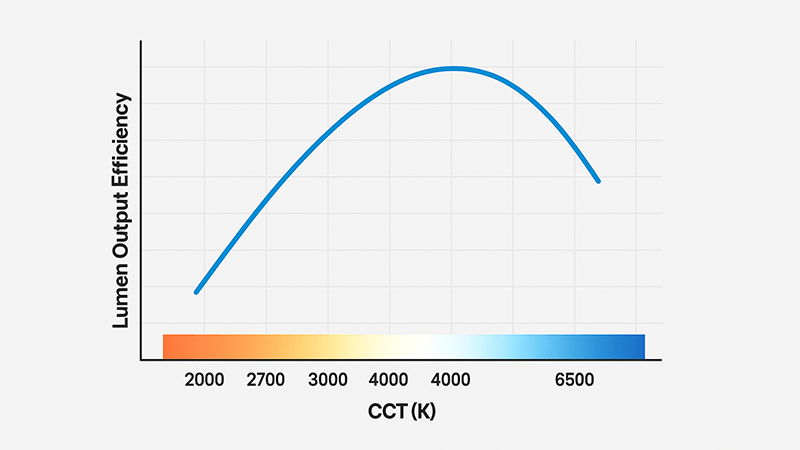
This is a technical point that often confuses buyers, but the reason is quite simple. A warmer light requires more phosphor coating on the LED chip to convert the blue light into a yellow, warmer tone. This conversion process causes a slight loss of energy, resulting in marginally fewer lumens. However, it's very important to put this into perspective. For most projects, this difference is too small to be a deciding factor.
The Science Behind Lumens and CCT
The difference in efficiency is a reality of LED manufacturing. A cool white LED needs less phosphor modification to achieve its color, making it slightly more efficient at converting electricity into light. A warm white LED requires a heavier, more complex phosphor layer, leading to a small drop in efficiency. For a typical 10-watt downlight, the difference might only be 50-100 lumens between a 3000K and a 5000K version. While this is measurable on a spec sheet, it's often not noticeable to the human eye in a real-world application.
Perception vs. Reality: Does it Matter?
This is the most important part. The human eye perceives cooler, bluer light as "brighter" or more intense than warmer, yellower light, even at the same lumen output. So, while a 5000K downlight might only be 5-7% more efficient in terms of lumens, it might feel 15-20% brighter to a person in the room. This psychological effect of CCT is far more significant than the minor technical difference in lumen output.
Here’s a practical example to illustrate this:
| LED Spec | 3000K Downlight | 5000K Downlight |
|---|---|---|
| Wattage | 10W | 10W |
| Lumen Output | ~850 lm | ~900 lm |
| Difference | - | ~6% more lumens |
| Perception | Soft & Bright | Crisp & Brighter |
My advice to purchasing managers like Shaz is always the same: choose the CCT for the mood and function of the space first. Don't chase the slightly higher lumen number of a cool white light9 if the application calls for a warm, cozy atmosphere. The perceived brightness of the cooler CCT can make a space feel uncomfortably harsh if used incorrectly. The quality of light, defined by the right CCT and a high CRI, is far more important than a minor gain in lumens.
Conclusion
In summary, CRI and CCT are vital for quality lighting. CRI ensures colors look true, while CCT sets the room's mood. Mastering these helps you choose the perfect IP44 downlights every time.
Staying updated on industry trends can help you make informed decisions about lighting solutions for various applications. ↩
IP44 downlights are designed for wet environments, ensuring safety and durability while providing effective lighting. ↩
Understanding CRI is essential for selecting lighting that accurately represents colors, enhancing the overall aesthetic of any space. ↩
CCT influences the mood and atmosphere of a room, making it crucial for creating the desired environment in any setting. ↩
A high CRI value is essential for accurate color representation, especially in spaces where appearance matters. ↩
Low CRI lighting can distort colors and negatively affect the ambiance of a space, making it less appealing. ↩
Proper lighting in damp-rated areas ensures safety and enhances the overall aesthetic of the space. ↩
Knowing how color temperature impacts lumen output can help in selecting the right lighting for specific needs. ↩
Cool white light promotes alertness and focus, making it suitable for offices and task-oriented environments. ↩

